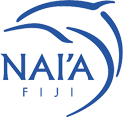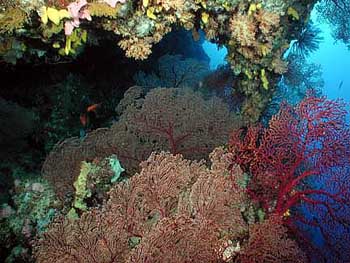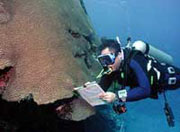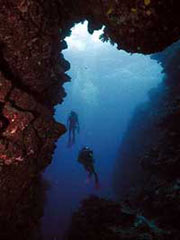|
Return to NAI'A
Conservation in Action
Date: April 28 - May 4, 2001
Destination: WWF Marine Survey - Great Astrolabe & North Astrolabe Reefs, Kadavu
|
 |
|
In another superb collaboration with the World Wide Fund for Nature - South Pacific Program, NAI'A this time journeyed to the most remote parts of the once-glorified Astrolabe reefs that surround Kadavu in the south. I had worked independently with WWF before, shooting photographs and video as part of their (now successful) campaign to create a Marine Protected Area near Ono Island in Kadavu. But with Sangeeta Mangubhai and Etika Rupeni from WWF, we concocted a plan to complete a more ambitious survey of the region to identify significant areas needing protection.
Several enlightened, forward-thinking chiefs and village leaders from the northern side of Kadavu have called out to WWF for help. They recognize that the much of the coral reef system that sustains them is dying - fished out, torn apart by anchors, smothered by silt and run off, devoured by crown of thorns, hammered by cyclones and pushed to possibly the final edge by globally rising sea temperatures and coral bleaching. The first step toward protection is to get under the water and find out first-hand what is going on. That's where we come in.
NAI'A offered herself as a research platform at only running costs to help WWF complete an urgent 5-day survey of the region. Led by Dr David Obura of CORDIO East Africa (a coral biologist and expert on rapid site assessment techniques), a team of 10 scientists and assistants gathered crucial information and images needed to produce for the government and traditional owners a report on the state of these reefs with recommendations for ways to protect them from further harm.
 |
A cavern brimming with sea fans and soft corals.
|
Certainly, it was a heartening project with which to be involved and I was thrilled have the hard-swimming job of surveying the predatory open-water fish species while also shooting photographs of the location and the survey work for WWF. Our favorite, pseudo-scientist Bruce Thayer joined us to shoot the central video transects while small fish counts came from Helen Sykes, our sometime NAI'A cruise director who is also a Masters of Science candidate and one of Fiji's most dedicated coral reef monitoring scientists. For Luis Morfin, our guest diving instructor who has been exploring Fiji with NAI'A for the past few months, it was his first experience on a marine survey project - not likely to be his last! |
 |
Etika Rupeni of WWF examines shallow hard coral species.
|
|
But it was also a rare chance to explore a new region for great sites and spend time diving and discussing coral reef ecology with marine biologists. Reef scientists and divers come to coral reefs from a very disparate perspective! All of us found that we had much to learn from each other. And we vowed to combine our knowledge and field experience more regularly. Myriad mysteries remain about the way coral reefs actually work and yet our generation is facing their demise!
Sadly, we discovered widespread coral devastation in some areas and only isolated pockets of healthy fish life. But we also identified some astonishing oases of abundance and beauty. Thanks to David, I am more and more convinced that the effort involved in diving windward sides of barrier reefs is well worth it! Our first dive on the inside corner of Naigoro Pass revealed some of the most stunning gardens of delicate hard branching corals we had seen anywhere. And our final dive at the northern end of North Astrolabe Reef took our breath away with its schooling barracuda and scad, leopard sharks, colorful soft coral drop-off caverns and bommies topped with healthy diverse hard coral communities. No one has a good answer as to why one section of reef is a mere skeleton of its former self; while just up the way another section thrives and throbs with life. But it did make us more determined and excited to do more exploratory diving and survey expeditions in Kadavu and thoughout Fiji.
Best "fishes"
Cat Holloway, Cruise Director - NAI'A |
 |
Leopard shark
|
 |
Bruce Thayer videos a field of corallimorphs.
|
|
FROM THE GUEST BOOK
What an expedition! What a team! Again with NAI'A we've been able to demonstrate how to get conservation science done and not just talk about it. And thank you for helping me find my David!
Sangeeta Mangubhai, World Wide Fund For Nature, South Pacific Program
What I like the most about coral reefs is that you never stop learning. With NAI'A it is impossible to consider reef survey work more efficient and enjoyable. May all your future cruises be as good as this one was.
Ed Lovell, Biological Consultants, Fiji
Another two trips on this wonderful boat. My big thanks to the crew for such excellent support.
David Obura, CORDIO East Africa
I would like to thank each and every one of you for your contribution to the WWF/Nai'a Scientific Expedition for the Great and North Astrolabe Reef. While the nature/state of the reefs was somewhat disheartening at times, it was a pleasure to work with such a cohesive hard working team to get all the survey work done. The interest we have subsequently had from government and other agencies has been very encouraging, and we hope the study will further our conservation work in Kadavu, and provide an example of how a variety of agencies with different experiences can come together to get conservation science done.
A special thanks goes to our volunteer helpers Helen, Luis and Bruce - we could not have collected the volume of data we did without you, and to Cat and the staff of Nai'a for assisting with the logistical arrangements, the surveys and providing financial assistance to make this trip happen.
Sangeeta Mangubhai & David Obura
|
 |
Samasoni Sauni from the University of the South Pacific gathers data near a giant porites colony.
|
 |
Etika Rupeni and Sangeeta Mangubhai explore a cavern.
|
|
|
|